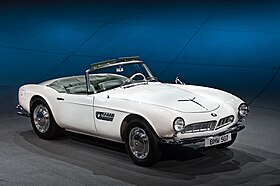BMW 507
| BMW 507 | |
|---|---|

BMW 507 at the 2009 Frankfurt Motor Show
|
|
| Overview | |
| Manufacturer | BMW |
| Production | 1956–1959 252 units built |
| Assembly | Milbertshofen, Bavaria, Germany |
| Designer | Albrecht von Goertz |
| Body and chassis | |
| Class | Grand tourer |
| Body style | 2-door convertible |
| Layout | FR layout |
| Related | BMW 503 |
| Powertrain | |
| Engine | 3168 cc M507/1 V8 |
| Transmission | 4-speed ZF manual |
| Dimensions | |
| Wheelbase | 2,480 mm (98 in) |
| Length | 4,380 mm (172.4 in) |
| Width | 1,650 mm (65.0 in) |
| Height | 1,257 mm (49.5 in) |
| Kerb weight | 1,330 kg (2,930 lb) |
| Chronology | |
| Successor | BMW Z8 |
The BMW 507 is a roadster that was produced by BMW from 1956 to 1959. Initially intended to be exported to the United States at a rate of thousands per year, it ended up being too expensive, resulting in a total production figure of 252 cars and heavy losses for BMW.
The BMW 507 was conceived by U.S. automobile importer Max Hoffman who, in 1954, persuaded the BMW management to produce a roadster version of the BMW 501 and BMW 502 saloons to fill the gap between the expensive Mercedes-Benz 300SL and the cheap and underpowered Triumph and MG sports cars. BMW engineer Fritz Fiedler was assigned to design the rolling chassis, using existing components wherever possible. Early body designs by Ernst Loof were rejected by Hoffman, who found them to be unappealing. In November 1954, at Hoffman's insistence, BMW contracted designer Albrecht von Goertz to design the BMW 503 and the 507.
Thirty-four Series I 507s were built in 1956 and early 1957. These cars had welded aluminium fuel tanks of 110 litres (29.1 US gal) capacity behind the rear seats. These large tanks limited both boot space and passenger space, and gave off the smell of fuel inside the car when the hood was erected or the hardtop was in place. Series II and later 507s had fuel tanks of 66 litres (17.4 US gal) capacity under the boot, shaped around a space for the spare tyre to fit.
The 507 frame was a shortened 503 frame, the wheelbase having been reduced from 2,835 millimetres (111.6 in) to 2,480 millimetres (98 in). Overall length was 4,835 millimetres (190.4 in), and overall height was 1,257 millimetres (49.5 in). Curb weight was about 1,330 kilograms (2,930 lb). The body was almost entirely hand-formed of aluminium, and no two models were exactly the same. 11 cars were sold with an optional hand-fabricated removable hardtop. Because of the car-to-car differences, each hardtop fits only the car for which it was made.
...
Wikipedia
